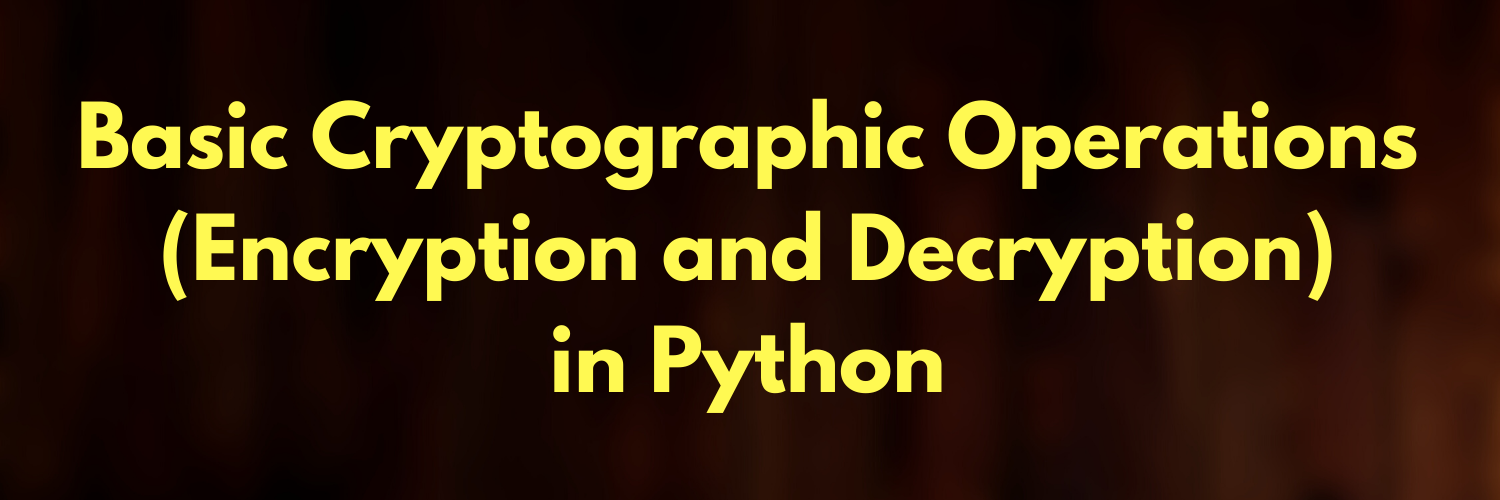Basic Cryptographic Operations (Encryption and Decryption) in Python
In this post we will take a look at the basic operations on cryptography (encryption and decryption) in python. We have an excellent module pycrypto that offers different built-in symmetric and asymmetric key cryptosystems.
Symmetric key cryptosystems use the same key to encrypt and decrypt a data or file. For example, DES and AES. Now-a-days, AES is the most common symmetric key cryptosystem.
Asymmetric key cryptosystems use two different mathematically related keys: one to encrypt and another to decrypt. For example, RSA and ECC.
Let’s first install the module:
pip install pycrypto
Symmetric Cryptography
DES
In the following examples, we will encrypt and decrypt our data using DES.
from Crypto.Cipher import DES
des = DES.new('eightchr', DES.MODE_ECB)
data = 'eightltr'
cipher_text = des.encrypt(data)
print(f"Encrypted Text: {cipher_text}")
print(f"Decrypted Text: {des.decrypt(cipher_text)}")
Here’s our output after running the program:
Encrypted Text: b'<e\x1d\xf2\xb2a\xa9a'
Decrypted Text: b'eightltr'
In the CFB mode, the object keeps changing each step. That’s why we will use seperate object to manage the key.
from Crypto.Cipher import DES
from Crypto import Random
iv = Random.get_random_bytes(8)
des_obj_1 = DES.new('eightchr', DES.MODE_CFB, iv)
des_obj_2 = DES.new('eightchr', DES.MODE_CFB, iv)
data = 'sixteencharacter' # multiple of eight
cipher_text = des_obj_1.encrypt(data)
print(f"Encrypted Text: {cipher_text}")
print(f"Decrypted Text: {des_obj_2.decrypt(cipher_text)}")
Here is the program output:
Encrypted Text: b'\x92\x9ckk9{3\x0b3\xc8\xef\xb1_\xb0\xd0v'
Decrypted Text: b'sixteencharacter'
AES
The following example offers encryption and decryption in python.
from os import urandom
from Crypto.Cipher import AES
def AES_encrypt(secret,iv,mode,data):
enc = AES.new(secret, mode, iv)
return data, enc.encrypt(data)
def AES_decrypt(secret,iv,mode,data):
dec = AES.new(secret, mode, iv)
return dec.decrypt(data).decode('utf-8')
if __name__=="__main__":
secret = urandom(16)
iv = urandom(16)
mode = AES.MODE_CBC
msg, encrypted_msg = AES_encrypt(secret, iv, mode, "this is a crypto")
print(encrypted_msg)
print(AES_decrypt(secret, iv, mode, encrypted_msg))
Asymmetric Cryptography
Let’s create public-private key pair using RSA. Then we will encrypt the data using the public key. And then we will use the private key to decrypt the ciphertext (encrypted data).
import Crypto.Random
from Crypto.PublicKey import RSA
from Crypto.Hash import SHA
import binascii
random = Crypto.Random.new().read
private_key = RSA.generate(1024, random)
public_key = private_key.publickey()
print("Private and Public Keys")
print(binascii.hexlify(private_key.exportKey(format='DER')).decode("ascii"))
print(binascii.hexlify(public_key.exportKey(format='DER')).decode("ascii"))
print("\n")
data = "this is a test"
cipher_text = public_key.encrypt(data.encode(), 32)
print(f"Encrypted Text: {cipher_text}")
print(f"Decrypted Text: {private_key.decrypt(cipher_text)}")
Private and Public Keys
3082025c02010002818100d622ee0ed403dda6a91f48426a80d16f76377c8fb1347f2e39a57d340fc807125a2c92eb6d22e4ef954a7c20f1d0ddcf9eb08d802e8324c71fbb46f683a3159aa87ebf8c1ca97f7824d7b5a8014541071f5a8c3b5ab3b4c3222be18ffdd1a5ecca9aa3114dc3a667e51f1588a486427a1625da4000b1d5d9a7d1181640b11b7b02030100010281805ac31f68059145e798137c4b3a5d33682d1143a89c11863e8f8c874f03c962c5f296a6074790dcbc77e8c4482a76bf2d7b3396265890998c14f50a14fea2a74ac94171dd4dd0062e107d140be363b9e2ba2c8db257c707f6b484b88f50d07ebf36fc0e115fe713a51131f0d9fc1ab2f2da73e6914e594ef4ae8bf538880570e1024100d8b65fc47166f312fe32555a33b8583dcba164f9905c2c97b472a719a324af8d16f594c47dd2211aac02ccff2220665d88101f2b7690397fccc7c6bd5a303a93024100fcf50179c7695db02025bfc5a233c7916c35171ef0cbe9bb5bc6b5e66cf636f17b52e0808cfeaab2d484c131574c444629462dc0898472e121ae06e5816c647902406604d4e8a18a197c2376867fc441502927277f658cf4177a0354c61d6793e9a0bde2367a99d0c60ccc5535341658b257eda9c942a8ba1497794bc2df7909a3490240296f3c89a5176648464bc8a8e7d3d179c99ebca5cdcda9008e9cf308c68a621f9612d2415c570ec0f23cb8a48b672bbbce60f777954f03be4ad505be2c400409024100d32b4ba44cd09ce69f101d8bab9bec67c60fff3c911b23b22f21a8ad8a969a31c8f643dda929b95cf40e3eb3b16dd1d06e3edcfe6b542cccfd034fbb9664bf5e
30819f300d06092a864886f70d010101050003818d0030818902818100d622ee0ed403dda6a91f48426a80d16f76377c8fb1347f2e39a57d340fc807125a2c92eb6d22e4ef954a7c20f1d0ddcf9eb08d802e8324c71fbb46f683a3159aa87ebf8c1ca97f7824d7b5a8014541071f5a8c3b5ab3b4c3222be18ffdd1a5ecca9aa3114dc3a667e51f1588a486427a1625da4000b1d5d9a7d1181640b11b7b0203010001
Encrypted Text: (b'\x97y\xdb\xd1\x16\x8b\xa7\xe4\xa4\xd7W\x11\x88.\xac\xa8\xa7j\xc3.y:\xde|\xd2\xcd\xafw;\x18\xe3\xbe\xe7\xf5\xed\n\xa1t\xd8\xfbVZ\x98\x18!F/\xec\xf3\t\xbdy\x1c\x06-\xe0 pN\xa7\x0e\xe8\xed\x18\xd3\x02\xc4\xa8&@\x04\x82\x050d\xa8\xb4V,\x12\x1b\xa0)\x1a\xaa\x1b\xfe6\x8fw\x1d=\xe5\xdd{L\xb0\x8c\xd7\x97\xa8\xc2M\x89s8S-\xe7\xc7<\xbb%\xd7\x05PH\xaf\xc5\x82\xc4\x06\x01\x1a\x180V\xf6',)
Decrypted Text: b'this is a test'



Leave a comment